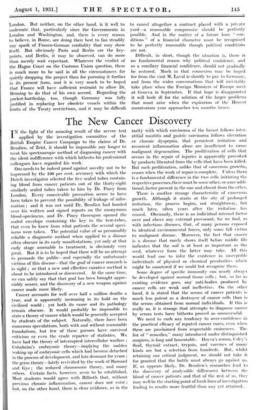The New Cancer Discovery TN the light of the amazing
result of the severe test applied by the investigation committee of the British Empire Cancer Campaign to the claims of Dr. Bendien, of Zeist, it should be impossible any longer to treat his spectroscopic method of diagnosing cancer with the silent indifference with which hitherto his professional colleagues have regarded his work.
One needs to be indeed proof against novelty not to be impressed by the 100 per cent. accuracy with which the Dutch investigator selected the five sealed tubes contain- ing blood from cancer patients out of the thirty-eight similarly sealed tubes taken to him by Dr. Piney from London. Every conceivable precaution seems to have been taken to prevent the possibility of leakage of infor- mation ; and it was not until Dr. Bendien had handed over his written and signed reports on the anonymous blood-specimens, and Dr. Piney thereupon opened the sealed envelope containing the key to the test-tubes, that even he knew from what patients the several speci- mens were taken. The potential value of so presumably reliable a diagnostic method when applied to a disease often obscure in its early manifestations, yet only at that early stage amenable to treatment, is obviously very great. But it is to be hoped that there will be no attempt to persuade the public—and especially the unfortunate victims of this disease—that the goal of cancer research is in sight ; or that a new and effective curative method is about to be introduced or discovered. At the same time, we can safely say that that goal has been brought appre- ciably nearer, and the discovery of a new weapon against cancer made more likely.
Cancer accounts for well over half a million deaths a year, and is apparently increasing in its hold on the civilized world ; yet both its cause and its pathology remain obscure. It would probably be impossible to state a theory of cancer which would be generally accepted by students of the subject. Naturally, there have been numerous speculations, both with and without reasonable foundations, but few of these guesses have survived criticism or even the crude repartee of statistics. We have had the theory of interrupted intercellular warfare ; Cohnheim's embryonic theory—implying the sudden waking up of embryonic cells which had become detached in the process of development, and lain dormant for years ; the germ theory—lately revivified by the work of Barnard and Gye ; the reduced chromosone theory, and many others. Certain facts, however, seem to be established. Most students would agree with Billroth that, without previous chronic inflammation, cancer does not exist ; but, on the other hand, there is clear evidence, as in the rarity with which carcinoma of the breast follows inter- stitial mastitis and gastric carcinoma follows ulceration or chronic dyspepsia, that persistent irritation and recurrent inflammation alone are insufficient to cause malignant degeneration. The proliferation of cells that occurs in the repair of injuries is apparently provoked by products liberated from the cells that have been killed. But such proliferation, unlike that of cancerous growths, ceases when the work of repair is complete. Unless there is a fundamental difference in the two cells initiating the respective processes,there must be some other, or some addi- tional, factor present in the one and absent from the other.
There is another strange characteristic of cancerous growth. Although it starts at the site of prolonged irritation, the process begins, not straightaway, but much later, often years after the irritation has ceased. Obviously, there is an individual internal factor over and above any external provocant, for we find, as with infectious diseases, that, of many persons exposed to identical environmental forces, only some fall victim to malignant disease. Moreover, the fact that cancer is a disease that rarely shows itself before middle life indicates that the soil is at least as important as the seed, whatever form the latter may take. All this would lead one to infer the existence in susceptible individuals of physical or chemical pecularitics which might be, countered if we could but recognize them.
Some degree of specific immunity can nearly always be developed against normal tissue cells ; but, so far as existing evidence goes, any anti-bodies produced by cancer cells are weak and ineffective. On the other hand, it is stated that the serum of cancer patients is much less potent as a destroyer of cancer cells than is the serum obtained from normal individuals. If this is really so, it is strange that attempts to diagnose cancer by serum tests have hitherto proved so unsuccessful.
We need to curb any tendency to over-confidence in the practical efficacy of reputed cancer cures, even when these are proclaimed from respectable eminences. The list of " remedies," many introduced under distinguished auspices, is long and lamentable. Doyen's serum, Coley's fluid, thyroid extract, trypsin, and vaccines of many kinds are but a selection from hundreds.. But, whilst retaining our critical judgment, we should not take it for granted that the battle must always go against us. If, as appears likely, Dr. Bendien's researches lead to the discovery of analysable differences between the blood of cancer patients and that of the rest of us, they May well be the starting point of fresh lines of investigation leading to results more fruitful than any yet attained..


































 Previous page
Previous page